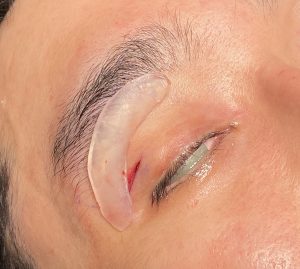Background: Aesthetic augmentation of the brow bone is done for either a masculinizing effect or for the correction of brow bone asymmetry. The former is best done using a custom brow bone implant that is placed through a small scalp incision using an endoscopic technique. Brow bone asymmetry, however, uses smaller implants which have the ability to potentially be placed through an inferior transpalpebral (eyelid) approach….if the asymmetry involves the tail of the brow bone.
The tail of the brow bone and the lateral orbital rim are connected at the frontozygomatic suture line. The lateral eyelid skin crease extends right next to the lateral orbital rim. This provides a convenient point of access to create the beginning of a subperiosteal pocket which can extend along the orbital rim/tail of the brow bone. This can be done through a very small upper eyelid incision that is usually no more than one centimeter.
Once the pocket is established the next consideration is what type of implant is to be used for the tail of the brow bone deficiency. Since there are no preformed brow bone implants, the shape of the tail of the brow bone must be formed from other implant materials such as ePTFE sheets/blocks or modifying existing infraorbital rim or even cheek implant shapes.




The lateral upper eyelid incision provides direct access to the lateral orbital rim and tail of the brow bone. It is used for a variety of procedures including lateral canthoplasies, tail of the brow bone reductions as well as positioning and screw fixation of endoscopically placed custom brow bone implants. As a result it can also be used for the placement of tail of the brow implants. The incision heals and is imperceptible.
Case Highlights:
1) Brow asymmetry may be capable of being improved by implants placed through an upper eyelid incisional approach.
2) The key is the shape of the implant which must be curved (C-shaped) if it wraps around the tail of the brow bone.
3) Blind tunnel dissection is done around the superior orbital rim to the infraorbital nerve notch for pocket creation.
Dr. Barry Eppley
Indianapolis, Indiana





